
구입 및 기술문의 : 010-4221-0660
LINEEYE released the first LE-series model in 1986. Since then, LINEEYE has been developing the LE Series protocol analyzers in response to the requirements of a large number of customers, and now come to the fruition of the LE-2500 and LE-3500, the newly designed latest models realizing great downsizing with a sharp reduction in weight.
It incorporates versatile analysis functions and excellent portability, thus fully supporting the development tests, after-sale services and trouble analysis. LE-series have been used in the industries of railways, aviation, and a variety of manufactures for few decades. With optional kits, it can be used for developing in-vehicle and embedded devices. Unlike the software based analyzers, it cannot be affected by the capability of PC and can be used in the place where PC is not allowed.

You can test measurement of high-speed communications up to 1.000Mbps (half duplex and full duplex). Using high precision DPLL technology for open baud rate support, transmission and reception speeds can be separately set to an effective 4 digits.
LE-2500 works as a serial port monitor/simulator, comes standard with measurement interface for RS-232C (V.24) and RS-422/485 (RS-530) standards. X.25, RS-449 and V.35 require only a dedicated cable.
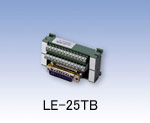
<Protocol setting display> | <Interface setting display> |
Protocols of differing hardware specifications are supported by simply changing the measurement boards.
 Simply pull out the interface board from the measurement unit and replace it with an expansion board for another protocol. | 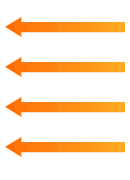 | OP-SB5GL | OP-1C+SB-25L |
 TTL TTLI2C |  Current CurrentLOOP | ||
| OP-SB6G | OP-SB7GX | ||
 IrDA IrDAASK |  CAN CANLIN |
| Built-in memory card interface | Memory card 8GB |
|---|---|
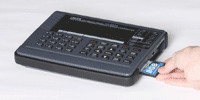 | CF-8GX |
| Target Line Speed (bps) | Continuous Recording Time Reference*1 | |
|---|---|---|
| Main memory Only | When Using CF-2GX | |
| 9600bps | Approx. 8min. | Approx. 120hrs. |
| 115.2Kbps | Approx. 40sec. | Approx. 10hrs. |
| 1Mbps | Approx. 5sec. | Approx. 76min. |
*1) When 1 kilobyte data is repetedly transmitted by full duplex with intervals of 1m second idle time for each. Both transmission and reception data consume 4 byte of memory for each capture.
Communication line timing is analyzed and displayed as a logic analyzer display to a time resolution of max. 50ns. The new function of signal voltage measurement ensures ease of the voltage measurement of RS-232C signals in places where tester probes cannot reach smoothly.


| The LE-PC300G supports serial connections through the COM port, USB connections, and LAN connections via LINEEYE SI-60 converter, thus enabling remote measurement by multiple analyzers connected at the same time. It also allows you to browse measurement data saved in memory card and convert data. | 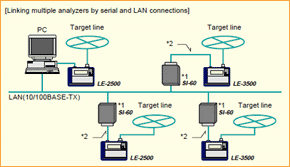 *1) SI-60 is a LAN-serial converter supported by LE-PC300G. Target analyzer is identified by specifying IP address of SI-60 on the remote setting window of LE-PC300G. *1) SI-60 is a LAN-serial converter supported by LE-PC300G. Target analyzer is identified by specifying IP address of SI-60 on the remote setting window of LE-PC300G.*2) optional AUX cable for DSUB 25-pin(LE2-8C). Set the DTE/DCE switch of SI-60 to DTE. |
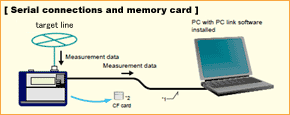 *1) The PC Link software is not provided with a USB cable. Prepare a USB cable if you intend to use USB connection. The LE2-8V AUX cable provided to the analyzer is available in the case of serial connection. *1) The PC Link software is not provided with a USB cable. Prepare a USB cable if you intend to use USB connection. The LE2-8V AUX cable provided to the analyzer is available in the case of serial connection.*2) An interface to read the CF card is required on the PC side. |
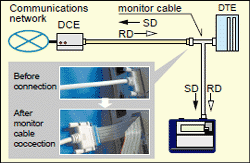
The online monitor function, like a sniffer, records telegrams in the capture memory and provides an easy-to-understand display for the type of protocol, without affecting the communications line.
LINE EYE protocol analyzers record not only communications data but the time (time stamp) of transmissions and receptions as well as idle time. Therefore, failure time and timeout status can be checked.
As a standard feature, the analyzer support various communications standards from asynchronous to packet switching systems.
Depending on the test, you can select bit transfer sequence and polarity, as well as modulation format from NRZ, NRZI, FMO, FM1 and 4PPM. The feature allows to support effective analysis by omitting SYN codes and using SDLC/HDLC address filter.
Record the data and the time of transmission / reception for data frames. ASYNC cannot recognize the length of frame. Thus, our analyzers decide the frame end when it finds the specific character, or when it passes the specific time of being non-communication. Time stamp will be displayed in above 2 situations.
* Specifies OFF, day / hour / minute, hour / minute / second, or minute / second / 10msec.
Non-communication state which works as the frame end detection time of ASYNC and Burst communications can be set from 1 to 100ms.
* If there are some frame with same time stamp, it is because the analyzer measured the frames in 10ms.
The amount of idle time between communications frames can be measured.
* Specifies OFF or a resolution of 100msec., 10msec. or 1msec.
The trigger feature allows you to specify a communications event as the trigger condition and have measurement operations executed automatically when that condition is specified. Up to four pairs of conditions and operations can be set, which is helpful towards identifying frequent intermittent faults that occurs with communications systems. And, the operation of a trigger condition can be specified as the condition for another trigger, making it possible to analyze complicated operations based on sequential trigger.
| <Trigger setup summary display> <Trigger condition setup>  <Trigger action setup>  |
The analyzers can analyze communications data and automatically set basic measuring conditions, such as communications speed, character framing, data code, synchronization character, BCC/FCS, etc. This is effective for monitoring lines of unknown communications conditions.
<Search display> | <Determination display> |
| A feature to measure the voltage of four RS-232C signal lines has been added to the conventional delay time function used to analyze the delay time of control line changes (e.g., RTS to CTS changes) at a resolution of 0.1ms. | <Delay time measurement> |
| With the simulation feature, the LINE EYE protocol analyzers act as the counterpart to the target device and perform transmission and reception tests according to protocol. Even in the early stages of development when matching devices are not available, tests can be run at near to actual operating status. After checking the communications protocol step by step in the analyzer's own original MANUAL mode, a developer can create a simple program to branch conditions using menu selection and test more complicated communications protocols. Communications speed can be freely set. Therefore, margins can be evaluated by intentionally shifting communications speed, and error response processing can be checked using test data that mixes in data with parity errors.
| Example of connection |
| The manual mode allows you to send the data registered in the transmission table which corresponds to the "0" to the "F" keys. The data can be set with one press of a key. While checking replies from a unit under development with the monitoring feature, you can easily and simply test the communications process. You can also send fixed data by registering it under a key combination of the SHIFT and "0" to "D" keys, as well as turn RTS/CTS and DTR/DCD signal lines on/off with the SHIFT and "E"/"F" key combinations. | <Transmission table setup display> |
| Flow control can be simulated on the transmission and reception-lines using X-on/off flow control or the control line handshake. In the transmission mode, up to 16 cycles of data from transmission start until a generated interrupt request can be displayed. In the reception mode, you can set the number of received data cycles until a transmission interrupt request is generated, as well as the time until the transmission resume request is generated. | <Flow control test setup display> |
| In the echo mode, the analyzer internally return received data. Buffer echo to send back data by a reception frame, character echo to send back data by a character and loop back echo that simply loops back data can be selected. It is used to test display terminals and communications terminals. | <ECHO mode setup display> |
| The polling mode simulates the slave and master units in multidrop (1:N connection) polling protocols. In the slave mode, the analyzer check the number of received frames that are assigned their address and whether errors occur or not, replying with user-set data. In the master mode, they send polling messages to 32 slave units, and check and display replies from each slave. | <Polling setup display> |
BERT support enables you to measure transmission quality of communications lines by a loop-back or interactive connection. It is possible to measure evaluation parameters (bit error count, block error count) conforming to ITU-T G.821 Notification, hence enabling bit error rate evaluations and fault point identification. Elaborate test patterns and functions such as bit error forced interrupt are comparable to dedicated equipment.
<BERT setting display> valuation is possible in ASYNC or SYNC mode, by specifying measurement period (continuous, received bits, duration) or test pattern. <BERT measurement display>  Once started, the results of measured line quality are displayed and updated in real time. | Example connection for BERT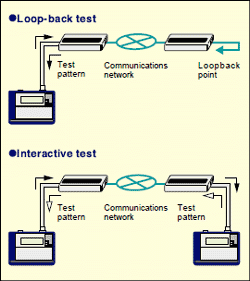 |
BERT Measurement Content
| Communication mode | Can select the ASYNC or SYNC mode. | ||||||||||||||||||||||||||||||
|---|---|---|---|---|---|---|---|---|---|---|---|---|---|---|---|---|---|---|---|---|---|---|---|---|---|---|---|---|---|---|---|
| Test Pattern |
| ||||||||||||||||||||||||||||||
| Pattern | 26-1, 29-1, 211-1, MARK, SPACE, ALT, DBL-ALT, 1in4, 1in8, 1in16, 3in24 | ||||||||||||||||||||||||||||||
| Measured Data |
|
| Anyone can easily operate the analyzer owing to the easy menu selection system handed down from earlier models. | <Top menu display> |
| Search Key | Communications error (individual error type can be specified), communications data string of max. 8 characters (DON'T CARE and bit mask can also be specified), idle time beyond a specified duration, specific time stamp (DON'T CARE can also be specified), external trigger matching data |
|---|---|
| Search Operation | Find and display, counting |
Measurement data displays can be freely scrolled and paged. A powerful search feature allows you to locate specific data and perform counting.
<Search key setting> | Using "DON'T CARE (*)," you can search for time stamp data from 10:30:00 to 10:39:59 as in this example. |
Test conditions and results such as measured data can be saved on optional CF cards in the file management format compatible with your PC. Of course, files can be interchangeably used between models. Therefore, measurement data can be saved on-site with LE-2500, and analyzed or manipulated in greater detail using LE-3500 back in the office.
* The LE-8200A, LE-8200, LE-3500, LE-2500, LE-7200, LE-3200, LE-2200, and LE-1200 are compatible in measurement data file. Part of files or data saved in higher hierarchy models or new models, hower, may not be available in lower hierarchy models or conventional models.
| Types, names, sizes and the data/time of files saved in the memory card can be checked. | <File operation display> |
| File type | Measurement data (.DT), Trigger save data (TG SAVEnn. DT), Auto save data (#nnnnnnn. DDT), Measurement Conditions (.SU), Transmission data for simulation (.ST), Simulation Program (.SP) |
|---|---|
| File operation | Displaying normal file or designated type of files, Save, Load, Deletion, Format |
| When many files have been saved, the file filter feature allows you to specify the type of file to be displayed. This is set to display data betwen 0:00 on August 1, 2008 and 23:59 on August 31, 2008. | <File filter setup> |
You can download the latest version of software from our website to take advantage of the latest functions and features. -> Download
| By setting time and a data of measurement start and end, measurement can be done automatically during the specified time period. | <Auto run display> |
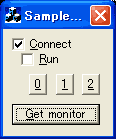
LINEEYE provides the LE series library of Visual C++ and Visual Basic. It enables you to devolop your own control systems collaborating other PC software in ashort period.
[ connect to LE series ]
| LEConnect | Connect to LE series |
| LEGetSetup | Get settings of LE series |
| LESetTable | Set trausmission data / tables |
| LEGetProgram | Get programs / data |
| LEStartMeasure | Strat measuring |
| LEGetMonitorData | Get monitored data |
| LEEmulationKey | Emulate keys of LE series |
LE series library is for using some useful functions by user-application. To use all functions of LE series on PC, use LE-PC300G.
Measurement data of a user-specified range can be printed out continuously from any printer. And, with a dedicated printer, you can print hard copy images of computer displays and continuous images of logic analyzer waveforms.
등록된 상품이 없습니다.
상품문의가 없습니다.